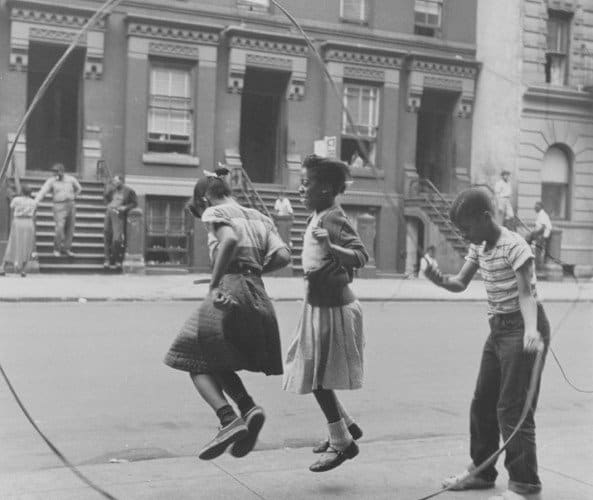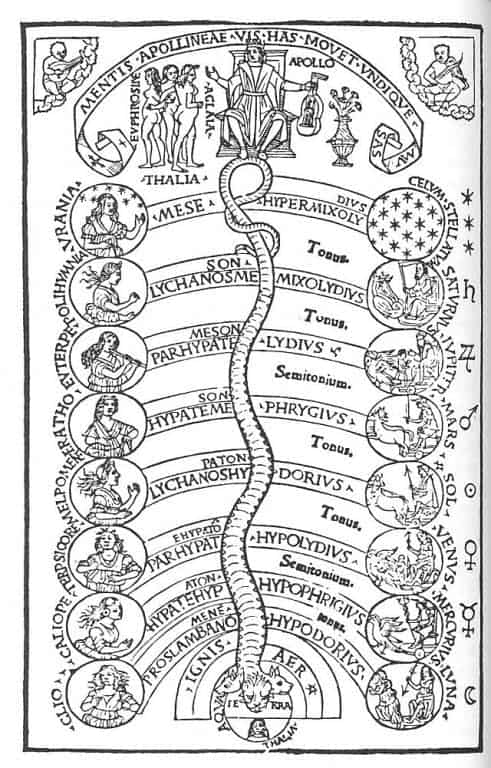Peel a banana upside down
See if you can touch the ground
If you spell your name correct
You may say the alphabet…
If you learn that rhyme, you can learn to sing. You can learn to speak a foreign language. You can learn to preach the Word.
It’s a jump rope song, as we called them when I learned them in the 80s. It’s the first poetry I learned by heart, not counting prayers.
When you skip rope you are forced to land, hard, over and over, on asphalt or cement. You stomp, stomp, stomp to a rhythm set by the rope-twirlers. And they shout — loud — wacky lines of slang that somehow give order and sense to it all. You feel the rhythm of the words in your bones. You have to memorize, or it just won’t work. And so the text enters your mind and your muscles and your imagination.
If you want to master language and music, you have to master rhythm. And jump rope songs teach rhythm with a lure as hypnotic as jungle drums.
Texico, Texico (the rope rocks back and forth, which is called “cradles”)
Over the hills to Mexico (the rope begins going all the way around)
Chinese dancers do the kicks, kicks, kicks (do kicks)
They do the splits, splits, splits (jump with legs apart)
They turn around, round, round (whirl around)
They touch the ground, ground, ground (touch the ground)
They get out of town (jump out)
You learn this stuff from other kids — other little kids, when you’re all six years old. Even at the time, you know something strange and strong is going on. Where is Mexico? What is a Chinese dancer? When you hear these sequences for the first time, it’s as if your slightly-older or better-versed peers have become possessed by an alien spirit.
Rhymes and consonant clusters and wordplay and jokes — sometimes bawdy ones — churn out of children at high volume to the relentless slap of the rope.
Miss Mary Mack, Mack, Mack
All dressed in black, black, black
With silver buttons, buttons, buttons
All down her back, back, back
She asked her mother, mother, mother
For fifteen cents, cents, cents
To see the elephant, elephant, elephant
Jump the fence, fence fence
He jumped so high, high, high
He touched the sky, sky, sky
And he didn’t come back, back, back
Till the fourth of July, ly, ly
Where do they get this stuff? Who was Mary Mack? It’s mysterious knowledge from beyond. Some think Mary Mack was a play on the name of the Civil War ironclad ship, the Merrimac. Then again, there was a Titanic victim called Mary Mack… was it her? No one really knows. (I am told that “fifteen cents” has since become fifty cents.)
Linguists tell us that jump rope songs flourish in every culture where children are free to play. If there’s no rope, there are clap songs and circle dances and “selection/exclusion rhymes” (“Eeny-meeny-miney-mo…” is one of those). There’s something atavistic about these chants. They teach essential human skills: language skills like diction and pronunciation, obviously, but also turn-taking, rule-setting, cooperation and competition. And they provide exercise.
The weirdest and most wonderful thing about these chants — especially now, in the virtual age — is that they aren’t mediated or produced or packaged in any way. You don’t learn them from TV. You learn them from other children, and none of you understand them. No one owns them. And yet they are preserved over decades and spread across whole continents just by being yelled over asphalt by people who weigh less than 50 pounds. Astonishing.
This is unchained, untamed folklore. It lives in a cranny of our culture, and long may it thrive. It’s human — an artefact — but who can call it artificial? It seems bigger than any of us.
To me, these chants are powerful.
Could I ever belong, really, in a society where I don’t know the jump rope songs? Could I write and speak my own language with music and pleasure if I didn’t have the “rhythm of the head”? If I didn’t have the thromp, thromp, thromp of “Cinderella dressed in yella” hammered into my joints?
Cinderella dressed in yella
Went downstairs to meet her fella
By a mistake she kissed a snake
How many kisses did she make?
One.
Two.
Three.
Four.
Five!
Jump rope songs make me think of the Faith. Maybe that seems flippant, but it’s not. Words give order to our actions. The sacraments — all seven of them — require the spoken word. The universe took shape when God said, “Let there be….” Words frame the world. Our Lord is called the Word, and by the Word the world is made.
The spheres sing of their Maker — a pounding, charming chant.
So what should we do about it? Jump in! By embracing meaning, we hasten our salvation. You have to know the song if you want to play. Shout, shout, shout — stomp, stomp, stomp — and the game gets fun. There’s a rhyme and a rule. There’s a rhythm. Know it. Call it out. Jump along with it, and you’re home free.




